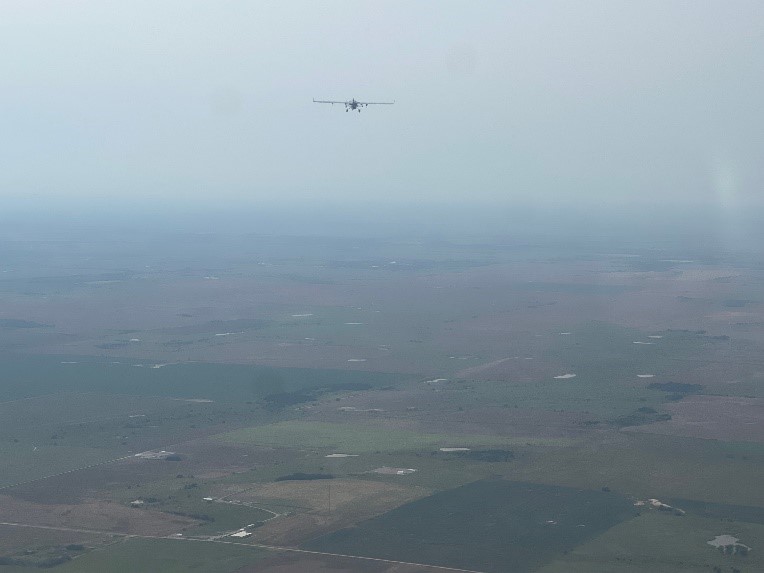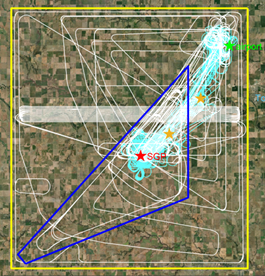August UAS Flights a Success; ArcticShark Call Opens
Published: 26 September 2023
Webinar on ARM uncrewed aerial system data a hit with user community

The skies above northern Oklahoma buzzed once again as the Atmospheric Radiation Measurement (ARM) user facility’s ArcticShark uncrewed aerial system (UAS) gathered atmospheric data, completing its third mission of 2023 at ARM’s Southern Great Plains (SGP) atmospheric observatory.
Unlike the previous SGP missions, the flights featured a chase plane that took the place of ground-based observers to maintain visual contact with the UAS and ensure there were no hazards, such as other aircraft in the area.
Beat Schmid, manager of the ARM Aerial Facility (AAF), says the chase plane concept not only worked well but expanded the ArcticShark’s operational envelope. In fact, the UAS team completed 39 hours in the air over 13 flights. During that time, the chase plane allowed ArcticShark operations to:
- double its range from the Blackwell-Tonkawa Municipal Airport from 13 to 26 miles
- expand the area covered from 29 to 380 square miles
- increase the flight altitude above sea level from 6,500 feet to 15,400 feet while maintaining 600 feet above ground level for low flights.
“We really achieved everything possible within the current FAA (Federal Aviation Administration) rules, the ArcticShark’s capabilities, and meteorological conditions encountered,” says Schmid.
Like ARM’s previous ArcticShark missions at the SGP (July 2022, March 2023, and June 2023), data from the August flight series are freely available to the research community on ARM Data Discovery.
Aerial Data Webinar a Hit
While Hollywood enjoyed the summer success of “Barbie,” “Oppenheimer,” and “Guardians of the Galaxy Vol. 3,” ARM had its own blockbuster with a live-action webinar, “ArcticShark Uncrewed Aerial System Data.” Fresh from its success in Oklahoma, the AAF team led a September 6 webinar with more than 50 attendees, who posed a slew of questions and exchanged information in the chat.
Schmid hosted the webinar, and AAF Science Lead Fan Mei provided the audience with a detailed overview of how to access and use ARM aerial data in research.
Five invited scientists provided examples of working with ARM aerial data. They were:
- Swarup China, Environmental Molecular Sciences Laboratory (EMSL)/Pacific Northwest National Laboratory
- Qi Zhang, University of California, Davis
- Jerry Tagestad, Pacific Northwest National Laboratory
- Jason Tomlinson, Pacific Northwest National Laboratory
- Hailong Wang, Pacific Northwest National Laboratory.
ArcticShark Campaign Calls

After the science example presentations, the sounds of pens furiously making notes could be heard across the internet as Schmid announced upcoming U.S. Department of Energy (DOE) ARM facility calls for ArcticShark campaigns.
The first call, which has since opened, is for a fiscal year 2024 campaign at the SGP with two existing, swappable science payloads. The schedule is as follows:
- preliminary proposals due November 1, 2023
- invited abbreviated proposals due December 22, 2023
- award selection expected before January 31, 2024.
View the proposal guidelines and how to submit for the open call.
A second call will be for a fiscal year 2025 campaign at the SGP and possibly the Bankhead National Forest atmospheric observatory in Alabama with two existing, swappable science payloads. The AAF team will visit the BNF region this fall to explore the feasibility of ArcticShark flights in that region. The anticipated schedule:
- call release in December 2023
- preliminary proposals due in February 2024
- abbreviated proposals due in April 2024
- award decision in July 2024.
Look for more proposal information coming soon on ARM.gov, or sign up for a free ARM account to receive proposal announcements and other facility news in your inbox.
‘A Long Flight Done Right’
Schmid says it is gratifying to see how much ARM’s UAS program has achieved.
“ARM’s user community has always expressed its desire for more aerial data, and DOE has responded by investing in ARM’s aerial capabilities,” says Schmid. “It’s important to know that this investment is more than the vehicle, the hangar, and instrumentation. It is also people. Over the past few years, we have hired expert staff and worked with leading consultants to bring the program to where it is today. Now, our job is to meet the aerial data needs of ARM users. It’s been a long flight done right.”
Keep up with the Atmospheric Observer
Updates on ARM news, events, and opportunities delivered to your inbox
ARM User Profile
ARM welcomes users from all institutions and nations. A free ARM user account is needed to access ARM data.


















